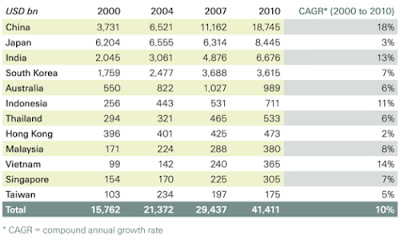Asia-Pacific Mortality Protection Gap – the time for action is now
A new study
published by Swiss Re in Asia-Pacific quantifies the total mortality protection
gap across 12 insurance markets to be USD 41 trillion.
Paul Turner,
Swiss Re’s Head of Client Management, Reinsurance Client Markets, Division
Globals, and David Alexander, Swiss Re’s Head of Business Development
Asia, joint authors of the report, highlight some key findings.
Despite numerous
industry studies and awareness campaigns, there is still a significant
mortality protection gap in all Asia-Pacific markets.
Swiss Re’s recently
published study, Mortality Protection Gap: Asia-Pacific 2011 – the first
to feature multiple Asia-Pacific markets – finds that the aggregate
mortality protection gap across 12 Asia-Pacific markets expanded significantly
from USD 16 trillion in 2000 to USD 41 trillion in 2010 (see figure
1).
This equates to a massive opportunity for the industry – the
mortality protection gap is worth approximately USD 124.2 billion in potential
premiums to the industry!
The
results of the study pose a number of questions on both the demand and supply
sides of life insurance.
Demand side:
- Does the traditional reliance on support from the extended family in Asia significantly reduce demand for insurance solutions and will this continue to be the case in the future?
- Will customers in Asia see the value of life insurance without an investment element and buy the required levels of protection?
Supply side:
- Is the industry doing enough to articulate the value and cost of life insurance products? Clear messages such as “for less than a cup of coffee per day, you can protect your family” can be very powerful motivators to act.
- Do our distribution channels offer the broadest access points to our products?
- Do we need to “reinvent” medical underwriting to remove sales barriers without compromising prudent risk management standards?
The
survey identifies the major barriers to purchasing insurance:
1) cost and
2)
lack of available funds.
Despite the perception that life insurance is
expensive, over half of the survey respondents are willing to pay at or even
above the market price for a life insurance product.
This gap in customer
perception is a clear opportunity for the life insurance industry.
In
addition to more customer education with regard to the benefits and costs of
life insurance products, life insurers are adopting a number of different
strategies including:
- Diversifying distribution channels and aligning channels with customer segments and products: for example, pure protection products such as term life insurance sold via direct marketing channels such as mail, telephone and the Internet.
- Proactively topping up the coverage of existing customers as they go through life and protection need changes and increases. Direct consumer marketing channels will often complement agency forces in this space.
- Introducing data analytics to target customers who match certain risk profiles and to significantly reduce the medical underwriting burden.
The Australian insurance industry has
led the way in the region in recent years, working collectively to promote
greater awareness of the benefits of life insurance protection to the general
public.
This work, together with an increase in alternative distribution
channels and sales of protection through superannuation funds, has helped
reduce the protection gap in Australia.
The
continuing growth of Asia-Pacific economies will drive the need for life
insurance protection.
Thus, there has never been a better time for insurers to
understand our customers’ protection needs, address challenges and work
together to capture the opportunities ahead of us.
Between April and May 2011, Swiss Re commissioned a large-scale survey covering
13,800 consumers aged 20 to 40 in Asia-Pacific; the survey aimed to gauge
consumer attitudes towards four risk aspects and look into the insurance needs
and buying behaviours of target consumers across the region.
Please
contact your Swiss Re client manager for further details on our research and
solutions relating to the protection gap.
Published
September 2011
Source: http://www.swissre.com/reinsurance/insurers/life_health/Mortality_Protection_Gap.html?mobile=iphone


Comments
Post a Comment